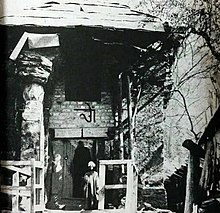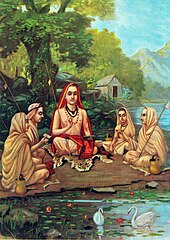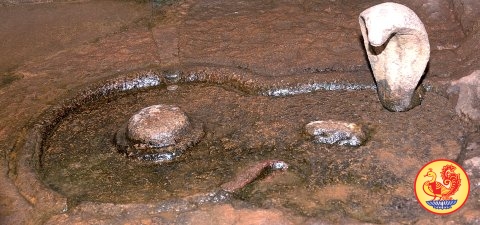


The Sharada Devi temple close to the Line of Control in Jammu and Kashmir was inaugurated on March 22 2023, after the panchaloha (five metals) vigraha idol of Mata Sharada reached Teetwal in Kashmir .. The place is about 150 km from Srinagar.
Sharada Peeth was originally an ancient Temple of Ma Sharada Devi or Saraswati coupled as a center of learning located in the Neelum valley of Pakistan occupied Kashmir.
It is 10 kilometres (6.2 mi) away from the border between Pakistani- and Indian-controlled areas of Kashmir. It is situated 1,981 metres (6,499 ft) above sea level, along the Neelum River.
History and etymology
Sharada Peeth translates to “the seat of Sharada”, or Mother Saraswathi Devi.

The beginnings of Sharada Peeth are uncertain, and the question of origins difficult, because Sharada Peeth was both a temple and an educational institution.
As a Centre of learning
Sharada Peeth is referred to by various historians, detailing its mythological status and prominence in ancient India. Its historical development is traced through references made to it by various historical sources. Although the Sharada script did not originate in Kashmir, it was used extensively in Sharada Peeth, and acquired its name from the institution.
As a temple
By the 8th century, the temple was a site of pilgrimage, attracting devotees By the 11th century, it was among the most revered places of worship in the Indian subcontinent. Significantly, it featured in list of the most famous Hindu temples in the Indian subcontinent.
Maa Sharada is the Brahma vidya Swarupini providing Jnana or knowledge to all.

Sharada Peeth has appeared in various historical and literary texts. Its earliest mention is in the Nilamata Purana (6th – 8th century CE).

Sarada temple is famous for the location where Adi Sankara has been bestowed with Sarvanja Peetham Award.
Here I am using inputs/ quotes from the book Athma Theertham written by Swami Remana charana theerthar Nochur Venkitaraman which details the life and teachings of Adi Sankaracharya.
Kashmir was ruled by King of Kashmir those days. Sarada Peeth had chairs for various philosophies/ religions including Budhism, Jainism, Advaitha, Ayurveda, fine arts. Sarada Peeth was upholding the culture of India.
Sarada temple was situated in the lower plains, surrounded by seven hills. Krishnaganga river flows to the west of the temple towards South. To the east side of the temple flows Madhumathi river and joins with Krishnaganga at this place. Sarada temple is situated to the north east of this point where the rivers meet. There were different departments for different subjects. Temple is in the middle of the Vidya peeth. Previously there was no specific idol but the blessing of Saraswathi was very evident. The temple had very knowledgeable priests.
King of Kashmir came and met Adi Sankaracharya at the banks of Krishnaganga (tributary of Jhelum river- Sindhu river) and invited him to the Conference at the Vidya Peeth of all specialists of different departments. The King sent emissaries to all over India and Nepal and invited Eminent philosophers before the arrival of Acharya. All specialists arrived at the various Departments for discussing with Acharya and get clarifications.
Acharya reached the South Entrance of the Temple. The inauguration of the Conference was held by igniting fire . First Acharya entered the Department of Nyaya, Vaisheshika. Acharya responded to all queries. Jnana is based on Vedic findings of Rishis who derived them through Tapas. Next was Sankhyas. Then Yoga of Patanjali. Subsequently Purva mimamsa, Saivam,Pashupatham, Vainshnavism, Pancharathram, Vaikhanasam . Acharya responded to all queries quoting Brahma Sutras and Vedic chants and provided clarity on all the subjects. Acharya insisted that Vedas is the basis of all systems and got wide acceptance from all those assembled.
Finally in the Conference of all philosophies all welcomed Acharya to the Saraswathi Kunda. Acharya entered the temple holding hands of his disciples like Padmapada and Sureshwaracharya, Thodakacharya and Acharya Hasthamalaka.
All recited ” Success to Acharya Sankara Bhagavadpada”. Disciple Chilsukan washed feets of Acharya. The King offered prayers at the feet of the Acharya and conducted Puja. Then Acharya saw Saraswathi theertham. The Holy person at the Saraswathi Kundam offered the Title ” Sarvajna” on Acharya Sankara Bhagavadpada.

Sarvanja Peetha as seen now.
At Kashmir, Acharya created the offering on Sarada or Saraswathi or Mahamaya known as ” Saundarya Lahari,” which is a superb text on Tantra , Maya and Sakthi worship.
Saundarya Lahari details the relationship between Sakthi and Siva. Just one verse is narrated below.
Sivakare manche paramasiva paryanka nilayam
Bhajanthi thwam dhanya kathichana chidananda lahareem. (verse 8)
Sarada or Sakthi is the force which runs the world as Maya on the static state of Siva . Mind is the same as Sakthi.
Visit and Stay at Sharada Peeth premises is detailed in the book Himagiri Viharam or Wanderings in the Himalayas by Swamy Tapovanam (1889- 1957). Swamy Tapovanam was Guru of Swamy Chinmayandaji who established Chinmaya Mission . One of the disciples of Swami Chinmayanandaji -Swami Thejomayananda- wrote some verses in praise of Swami Tapovanam.
I will quote the first verse of Tapovana Sthuthi written by Swami Tejomayananda of Chinmaya Mission as below:
Tapovananjali
Sanyasa dharmena parena yuktho virochamano purusho gatho hi
Himalayam sarva nagadhirajam dhathum yashasvasya nivasanena
Kashyutharancha kruthadhivaso Ganga thate yo yathi raja varya
Sa vai gurorno gururaja pujya Namna prasidhamcha Thapovanam Vai.
Endowed with supreme renunciation, the brilliant person went to the Himalayas- the King of Mountains- to bestow glory on it by dwelling there. The best of sanyasis who made Uttarakashi on the banks of the Ganga as his abode indeed the revered Guru of our Guru and is well known by the name “THAPOVANAM”
Some details from “Wanderings in the Himalayas”. I am reading the book in Malayalam now, so English version not available with me now. So the translation I have done for the time being. I will update the post from quotes from English version when I get the book.
Swami Thapovanam visited Kashmir in May 1927. Swamy details about the Sankara mountains at 6000 ft above sea level near Shrinaagar where Sage Adi Sankara has installed idol of Lord Siva. It is called Sankaracharya Temple. Temple location provides a broad view of the Srinagar and Kashmir valley.
Swami Tapovanam mentions Brahmins and Muslims as the inhabitants of Kashmir. All the servants of Brahmins were Muslims as there were no other castes in the valley in those days. Muslim ladies also dressed like Brahmin ladies as per Swami.
Eating flesh of goats was common in Kashmir even for Kashmiri Brahmins.
Swami Thapovanam states about the beauty and intelligence of Kashmiri Brahmins. Kashmiri Muslims are mostly converted Brahmins and they are also equally beautiful. Thapovanam recalls some of the famous philosophers from Kashmir such as Mandanamishran, Mammadabhattan, and Abhinavaguptan.
The temple is at the western end of Himalayas at 11000 feet height above sea level. (Overall, Kashmir valley is at 5300 feet height above sea level) Temple is surrounded by snow mountains, hilly forests.
There was only a house for the priest and huts of Muslims at a distance. There were not many visitors to the temple. Swamy felt it was a holy temple. Swamy stayed at the Chuttambalam or area within the outer walls of the temple used by the priests and related folks normally for preparatory works within the temple.
It was very cold but timber was available in plenty for fire and warming.
Swamiji starts with detailing the beauty of Kashmir Valley. Srinagar is in the middle of Kashmir Valley and on the banks of Jhelum River. Kashmir was the holy location of Ashrama of Kashyapa Maharishi. River Jhelum flows through the middle of Kashmir valley. Srinagar is on the banks of River Jhelum.
Swamiji details the current conditions of the temple. It was then, vacant land with frequent incursions by wild animals. It was occupied by mostly uneducated Muslims in the area.
Swamiji has conducted walks and exploration in the premises and found ancient bricks below the surface soil. Swamiji says the change from forest to villages and vice versa was common in mountains as well as valleys in those days.
Swamiji quotes from ” “Sankara Digvijayam”
“Samshravayannadhwani Deshikendra:
Shri Dakshina Dwarabhuvam Prapede
Kavadam udghatya niveshtu kamam
Sasambhramam Vadi ganonyar outseeth”
Here comes Guru Sankara as King Lion overcoming the challenges from elephants. Acharya Sankara reached the Southern gate of the temple, opened the gate and tried to enthrone in the Sarvajna Peetha or seat of the person who knows all beyond which there is nothing to know.
In the 14th century text Madhaviya Shankara Vijayam, there is a test, unique to Sharada Peeth, known as the Sarvajna Peetham, or Throne of Omniscience. These were four thrones, each representing an entrance of the temple corresponding to one of the points of the compass, which only a learned man from that direction could symbolically open.

Adi Shankara, being from South India, took it upon himself to pass this challenge, because although the other doors had been opened, no one from the south of Kashmir had yet been successful. He was welcomed by the common people, but challenged by the scholars of the region. As he approached the southern door, he was stopped by various learned men from the Nyaya or reasoning school of philosophy, Budhists, Jains, and others. Engaging with them, he managed to persuade all of them of his proficiency in philosophy and true vedic knowledge, and they stood aside to let him open the entrance.
Finally, as he was about to ascend the throne, he heard the voice of the goddess Sharada challenging him. The voice said that omniscience was not enough if one was impure, and that Shankara, who lived in the palace of King Amaruka, could not be pure. Shankara replied that his body had never committed a sin, and the sins committed by another could not blemish him. The goddess Sharada accepted his explanation and permitted him to ascend.
Tapovanam Swamiji did not see any gate on the Southern side. Only one entrance on the western side. So we have to guess that changes have happened to the temple over the years from Acharya Sankara visit to Swami Tapovanam visit (between 8th century and 20th century) by which time the region have suffered many attacks from the West. In the Temple Swamiji saw Shree Chakra and different idols within the shape of a Chakra or circle. There was a central Peetam or central island stand which has turned red due to application of sindhoora (Vermillion – reddish orange powder which consists of cinnabar or powdered red lead) as offering to goddess Saraswathi.
In the Karnatic song Kalavathi kamalasana yuvathi, the 19th-century composer Muthuswami Deekshithar refers to Sharada Peeth as abode of Matha Saraswati. Kāśmīra vihāra, vara śāradā. (The one who resides in Kashmir, Sharada.)
Sharada Stotram
Prayer composed by Adi Sankaracharya:
Namaste Sarada Devi Kashmira mandala vasini.
Tvam aham prarthaye nityam vidyadanam cha dehi meim…..1
I bow to the Goddess Sharada, who lives in Kashmir. I pray to bestow on me self wisdom.
Namaste-Salutations; sharada devi-Godess of wisdom; Kashmirapuravasini-one who abides in Kashmira; twamaham prarthate nityam-always I pray you; vidya danancha dehime-bestow the self wisdom
Ya shradha dharana medha vagdevi vidhi vallabha
Bhaktha jihvagra sadana samadi guna dayini……2
You are faith, memory, intelligence, the divinity of speech, the Spouse of Creator, Brahma. You
grace the devotees speech, You are the bestower of inner peace, and all other excellences.
Namami yaminim natha lekhalankrta kuntalam
Bhavanim bhava santapa nirvapana sudanadim….3
I bow down to Bhavani who is decorated with ear ornament studded with the flash of lightning,
who is a river of nectar that cures the torments of worldly life.
Bhadrakalyai namo nithyam saraswathyai namo nama
Veda vedanga vedanta vidya sthanebhya eva cha….4
Constant Salutations to Thee, O Mother Beneficent! You are the stay of Veda and the auxillary
branches of the Veda, of the Vedanta and all other forms of learning. Salutations to You, O
Goddess of Learning.
Brahma swaroopa parama jyothi rupa sanatani
Sarva vidyadhi devi ya tasyai vanyai namo nama ….5
O Mother, You are the personification of Brahman. You are the Supreme Spirit, the light Divine,
the Eternal Being. You are the Presiding Deity in all branches of learning. Salutations to You, O
Goddess of Learning.
Ya ya vina jagat sarvam sasvat jivamritam bhavet
Jnanadhi devi ya tasyai sarasvatyai namo nama…6
But for You the whole world would appear lifeless. You are the Presiding Deity of Knowledge.
Salutations to You, O Goddess of Learning.
Yaya vina jagat sarvam mukam unmatha vatsada
Ya devi vagadhishtatri tasyai vanyai namo nama….7
But for You the whole world would appear dump and demented. You are the Presiding Deity of
Speech. Salutations to You, O Goddess of Speech.
…
Sringeri Sharada Peetham
It is believed that Goddess Sharadambika is the incarnation of Goddess Saraswati, who came to Earth as Ubhaya Bharathi. It is a common faith that by worshiping her, one can receive blessings of Brahma, Shiva, and Vishnu along with Parvati, Lakshmi, and Saraswati.
Sharda is the goddess of the temple town of Sringeri in Karnataka, South India and is an incarnation of Goddess Saraswati. In Hinduism Saraswati is the goddess of knowledge, music and the arts. She is the consort of Brahma. Saraswati is considered to be the “mother of the Vedas”
Jagadguru Sri Adi Shankara Bhagavatpada established the first of the four Amnaya Peethams at Sringeri more than twelve centuries ago to foster the sacred tradition of Sanatana Dharma.
When the Acharya came to Sringeri, he saw an unusual sight on the banks of the Tunga. A cobra was seen spreading out its hood over a frog in labour pains, to give it shadow from the scorching mid-day sun. Struck with the sanctity of the place, which could infuse love between natural adversaries, the Acharya chose this very location to establish His first Math.

The Acharya appointed his prime disciple, Sri Sureshwaracharya as the first Acharya of the Peetham. Since then, the Peetham has been blessed with an unbroken Guru Parampara, a garland of spiritual masters and Jivanmuktas representing Sri Adi Shankaracharya. The succeeding Acharyas have led a life of such austere penance that it has led disciples to adore in them the radiance of Sri Adi Shankara Himself.
Besides being a centre of spiritual power, Sringeri also came to be known as a great place of traditional learning owing to the presence of Goddess Sharada and the erudition of the Acharyas of the Peetham. The Acharyas were instrumental in bringing forth commentaries on the Vedas and in further expounding the Bhashyas of Sri Adi Shankaracharya. The Acharyas also wrote a number of independent works related to Advaita besides producing a number of hymns underlining their ardent devotion to the non-dual Supreme worshipped in multifarious forms. The Peetham thus came to be regarded as the Vyakhyana Simhasana, The Throne of Transcendental Wisdom.
OM SATH THATH